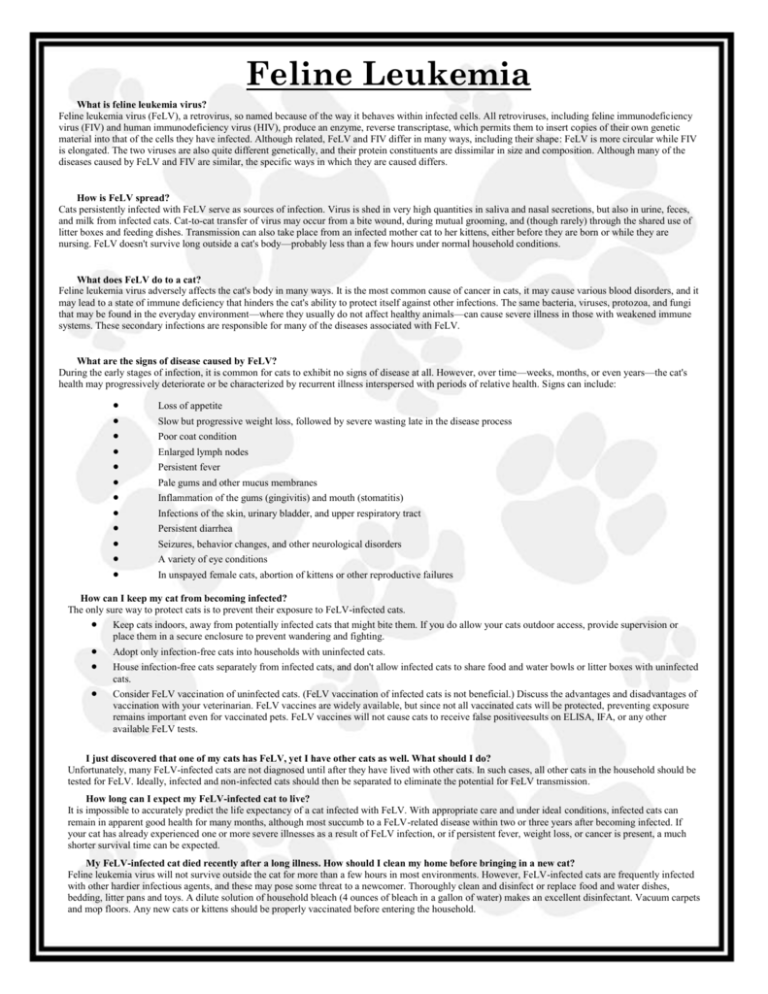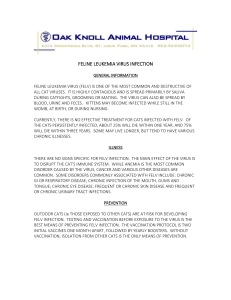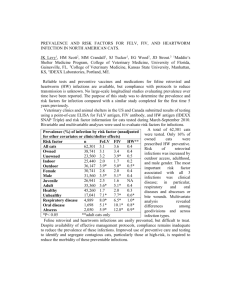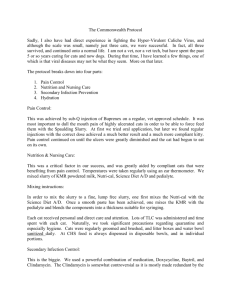Feline Leukemia
advertisement

Feline Leukemia What is feline leukemia virus? Feline leukemia virus (FeLV), a retrovirus, so named because of the way it behaves within infected cells. All retroviruses, including feline immunodeficiency virus (FIV) and human immunodeficiency virus (HIV), produce an enzyme, reverse transcriptase, which permits them to insert copies of their own genetic material into that of the cells they have infected. Although related, FeLV and FIV differ in many ways, including their shape: FeLV is more circular while FIV is elongated. The two viruses are also quite different genetically, and their protein constituents are dissimilar in size and composition. Although many of the diseases caused by FeLV and FIV are similar, the specific ways in which they are caused differs. How is FeLV spread? Cats persistently infected with FeLV serve as sources of infection. Virus is shed in very high quantities in saliva and nasal secretions, but also in urine, feces, and milk from infected cats. Cat-to-cat transfer of virus may occur from a bite wound, during mutual grooming, and (though rarely) through the shared use of litter boxes and feeding dishes. Transmission can also take place from an infected mother cat to her kittens, either before they are born or while they are nursing. FeLV doesn't survive long outside a cat's body—probably less than a few hours under normal household conditions. What does FeLV do to a cat? Feline leukemia virus adversely affects the cat's body in many ways. It is the most common cause of cancer in cats, it may cause various blood disorders, and it may lead to a state of immune deficiency that hinders the cat's ability to protect itself against other infections. The same bacteria, viruses, protozoa, and fungi that may be found in the everyday environment—where they usually do not affect healthy animals—can cause severe illness in those with weakened immune systems. These secondary infections are responsible for many of the diseases associated with FeLV. What are the signs of disease caused by FeLV? During the early stages of infection, it is common for cats to exhibit no signs of disease at all. However, over time—weeks, months, or even years—the cat's health may progressively deteriorate or be characterized by recurrent illness interspersed with periods of relative health. Signs can include: Loss of appetite Slow but progressive weight loss, followed by severe wasting late in the disease process Poor coat condition Enlarged lymph nodes Persistent fever Pale gums and other mucus membranes Inflammation of the gums (gingivitis) and mouth (stomatitis) Infections of the skin, urinary bladder, and upper respiratory tract Persistent diarrhea Seizures, behavior changes, and other neurological disorders A variety of eye conditions In unspayed female cats, abortion of kittens or other reproductive failures How can I keep my cat from becoming infected? The only sure way to protect cats is to prevent their exposure to FeLV-infected cats. Keep cats indoors, away from potentially infected cats that might bite them. If you do allow your cats outdoor access, provide supervision or place them in a secure enclosure to prevent wandering and fighting. Adopt only infection-free cats into households with uninfected cats. House infection-free cats separately from infected cats, and don't allow infected cats to share food and water bowls or litter boxes with uninfected cats. Consider FeLV vaccination of uninfected cats. (FeLV vaccination of infected cats is not beneficial.) Discuss the advantages and disadvantages of vaccination with your veterinarian. FeLV vaccines are widely available, but since not all vaccinated cats will be protected, preventing exposure remains important even for vaccinated pets. FeLV vaccines will not cause cats to receive false positiveesults on ELISA, IFA, or any other available FeLV tests. I just discovered that one of my cats has FeLV, yet I have other cats as well. What should I do? Unfortunately, many FeLV-infected cats are not diagnosed until after they have lived with other cats. In such cases, all other cats in the household should be tested for FeLV. Ideally, infected and non-infected cats should then be separated to eliminate the potential for FeLV transmission. How long can I expect my FeLV-infected cat to live? It is impossible to accurately predict the life expectancy of a cat infected with FeLV. With appropriate care and under ideal conditions, infected cats can remain in apparent good health for many months, although most succumb to a FeLV-related disease within two or three years after becoming infected. If your cat has already experienced one or more severe illnesses as a result of FeLV infection, or if persistent fever, weight loss, or cancer is present, a much shorter survival time can be expected. My FeLV-infected cat died recently after a long illness. How should I clean my home before bringing in a new cat? Feline leukemia virus will not survive outside the cat for more than a few hours in most environments. However, FeLV-infected cats are frequently infected with other hardier infectious agents, and these may pose some threat to a newcomer. Thoroughly clean and disinfect or replace food and water dishes, bedding, litter pans and toys. A dilute solution of household bleach (4 ounces of bleach in a gallon of water) makes an excellent disinfectant. Vacuum carpets and mop floors. Any new cats or kittens should be properly vaccinated before entering the household.







